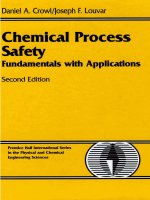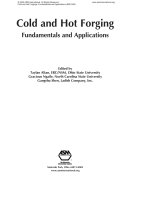Thermodynamics fundamentals for applications o’connell, j p haile, j m
Bạn đang xem bản rút gọn của tài liệu. Xem và tải ngay bản đầy đủ của tài liệu tại đây (7.15 MB, 664 trang )
THERMODYNAMICS
Fundamentals for Applications
Other Books by the Authors
J. P. O’Connell
Computer Calculations for Multicomponent Vapor-Liquid Equilibria (coauthor)
Computer Calculations for Multicomponent Vapor-Liquid and LiquidLiquid Equilibria (coauthor)
The Properties of Gases and Liquids (coauthor of 5th edition)
J. M. Haile
Molecular-Based Study of Fluids (coeditor)
Chemical Engineering Applications of Molecular Simulation (editor)
Molecular Dynamics Simulation
Technical Style: Technical Writing in a Digital Age
Lectures in Thermodynamics: Heat and Work
Analysis of Data
THERMODYNAMICS
Fundamentals for Applications
J. P. O’Connell
University of Virginia
and
J. M. Haile
Macatea Productions
cambridge university press
Cambridge, New York, Melbourne, Madrid, Cape Town, Singapore, São Paulo
Cambridge University Press
The Edinburgh Building, Cambridge cb2 2ru, UK
Published in the United States of America by Cambridge University Press, New York
www.cambridge.org
Information on this title: www.cambridge.org/9780521582063
© J. P. O'Connell and J. M. Haile 2005
This publication is in copyright. Subject to statutory exception and to the provision of
relevant collective licensing agreements, no reproduction of any part may take place
without the written permission of Cambridge University Press.
First published in print format 2005
isbn-13
isbn-10
978-0-511-11533-2 eBook (NetLibrary)
0-511-11533-4 eBook (NetLibrary)
isbn-13
isbn-10
978-0-521-58206-3 hardback
0-521-58206-7 hardback
Cambridge University Press has no responsibility for the persistence or accuracy of urls
for external or third-party internet websites referred to in this publication, and does not
guarantee that any content on such websites is, or will remain, accurate or appropriate.
If it were easy … it cannot be educational.
In education, as elsewhere, the broad
primrose path leads to a nasty place.
Alfred North Whitehead
“The Aims of Education,” in
Alfred North Whitehead, An Anthology,
F. S. C. Northrop and M. W. Gross, eds.,
Macmillan, New York, 1953, p. 90.
remarkable things
occur in accordance with Nature,
the cause of which is unknown;
others occur contrary to Nature,
which are produced by skill
for the benefit of mankind.
Mechanica, Aristotle (384–322 BCE)
Many scholars doubt that the Mechanica,
the oldest known textbook on engineering,
was written by Aristotle. Perhaps it was written
by Straton of Lampsacus (a.k.a. Strato Physicus,
died c. 270 BCE), who was a graduate student
under Aristotle and who eventually succeeded
Theophrastus as head of the Peripatetic school.
CONTENTS
Preface, xiii
Acknowledgments, xvi
0. Introduction, 1
0.1
0.2
0.3
0.4
Natural Phenomena, 1
Thermodynamics, Science, and Engineering, 2
Why Thermodynamics Is Challenging, 5
The Role of Thermodynamic Modeling, 7
Literature Cited, 8
PART I. THE BASICS, 9
1. Primitives, 10
1.1
1.2
1.3
1.4
1.5
Primitive Things, 10
Primitive Quantities, 15
Primitive Changes, 20
Primitive Analyses, 24
Summary, 26
Literature Cited, 27
Problems, 28
2. The First and Second Laws, 32
2.1
2.2
2.3
2.4
2.5
Work, 34
The First Law, 43
The Second Law, 48
Thermodynamic Stuff Equations, 55
Summary, 63
Literature Cited, 64
Problems, 64
x
CONTENTS
3. Fundamental Relations, 69
3.1
3.2
3.3
3.4
3.5
3.6
3.7
3.8
State of Single Homogeneous Phases, 70
Fundamental Equations, 74
Response to a Change in T, P, or V, 80
Response to a Change in Mole Number, 88
Differential Relations Between Conceptuals and Measurables, 96
Generalized Stuff Equations, 98
General Expressions for Heat and Work, 104
Summary, 111
Literature Cited, 113
Problems, 113
PART II. SINGLE-PHASE SYSTEMS, 119
4. Properties Relative to Ideal Gases, 120
4.1
4.2
4.3
4.4
4.5
4.6
Ideal Gases, 121
Deviations from Ideal Gases: Difference Measures, 133
Deviations from Ideal Gases: Ratio Measures, 137
Conceptuals from Measurables Using Equations of State, 146
Simple Models for Equations of State, 152
Summary, 174
Literature Cited, 175
Problems, 177
5. Properties Relative to Ideal Solutions, 184
5.1
5.2
5.3
5.4
5.5
5.6
5.7
Ideal Solutions, 185
Deviations from Ideal Solutions: Difference Measures, 189
Excess Properties from Residual Properties, 194
Deviations from Ideal Solutions: Ratio Measures, 200
Activity Coefficients from Fugacity Coefficients, 208
Simple Models for Nonideal Solutions, 211
Summary, 219
Literature Cited, 221
Problems, 222
6. Relations Among Relations, 228
6.1
6.2
6.3
6.4
6.5
6.6
Effects of External Constraints on System States, 229
Symmetry in Routes to Conceptuals, 231
Physical Interpretations of Selected Conceptuals, 239
Five Famous Fugacity Formulae, 243
Mixing Rules from Models for Excess Gibbs Energy, 247
Summary, 249
Literature Cited, 250
Problems, 251
CONTENTS
PART III. MULTIPHASE AND REACTING SYSTEMS, 255
7. Transfers, Transformations, and Equilibria, 256
7.1
7.2
7.3
7.4
7.5
7.6
7.7
The Laws for Closed Nonreacting Systems, 257
The Laws for Open Nonreacting Systems, 269
Criteria for Phase Equilibrium, 279
The Laws for Closed Reacting Systems, 286
The Laws for Open Reacting Systems, 300
Criteria for Reaction Equilibrium, 303
Summary, 305
Literature Cited, 307
Problems, 307
8. Criteria for Observability, 310
8.1
8.2
8.3
8.4
8.5
Phase Stability in Closed Systems, 311
Pure Substances, 320
Phase Stability in Open Systems, 336
Fluid Mixtures, 340
Summary, 356
Literature Cited, 359
Problems, 360
9. Phase Diagrams for Real Systems, 366
9.1
9.2
9.3
9.4
9.5
9.6
9.7
Thermodynamic State for Multiphase Systems, 367
Pure Substances, 371
Binary Mixtures of Fluids at Low Pressures, 375
Binary Mixtures Containing Solids, 393
Binary Mixtures of Fluids at High Pressures, 399
Ternary Mixtures, 405
Summary, 410
Literature Cited, 412
Problems, 414
PART IV. ENGINEERING CALCULATIONS, 419
10. Options for Equilibrium Calculations, 420
10.1
10.2
10.3
10.4
10.5
Basic Phase-Equilibrium Relations, 421
Choices for Standard States in Gamma Methods, 428
Basic Reaction-Equilibrium Relations, 443
Preliminaries to Reaction-Equilibrium Calculations, 456
Choosing an Appropriate Form in Applications, 468
Literature Cited, 470
Problems, 471
xi
xii
CONTENTS
11. Elementary Computational Procedures, 477
11.1
11.2
11.3
11.4
Phase-Equilibrium Calculations, 478
One-Phase Reaction-Equilibrium Calculations, 499
Multiphase Reaction-Equilibrium Calculations, 511
Summary, 519
Literature Cited, 521
Problems, 522
12. Selected Applications, 529
12.1
12.2
12.3
12.4
12.5
12.6
Phase Equilibria, 529
Solubilities, 542
Independent Variables in Steady-Flow Processes, 550
Heat Effects in Steady-Flow Processes, 555
Response of Selected Properties, 571
Summary, 577
Literature Cited, 579
Problems, 579
AFTERWORD, 585
APPENDICES, 589
A.
B.
C.
D.
E.
F.
G.
H.
I.
J.
K.
Tools from the Calculus, 590
Elements of Linear Algebra, 606
Solutions to Cubic Equations, 620
Vapor Pressures of Selected Fluids, 622
Parameters in Models for G Excess, 623
A Stability Condition for Binaries, 627
Notation in Variational Calculus, 629
Triangular Diagrams, 631
Lagrange Multipliers, 634
NRTL Model, 636
Simple Algorithms for Binary VLLE, 639
Notation, 641
Index, 646
0
INTRODUCTION
Y
ou are a member of a group assigned to experimentally determine the behavior of
certain mixtures that are to be used in a new process. Your first task is to make a
1000-ml mixture that is roughly equimolar in isopropanol and water; then you will
determine the exact composition to within ±0.002 mole fraction. Your equipment consists of a 1000-ml volumetric flask, assorted pipettes and graduated cylinders, a thermometer, a barometer, a library, and a brain. You measure 300 ml of water and stir it
into 700 ml of alcohol—Oops!—the meniscus falls below the 1000-ml line. Must have
been careless. You repeat the procedure: same result. Something doesn’t seem right.
At the daily meeting it quickly becomes clear that other members of the group are
also perplexed. For example, Leia reports that she’s getting peculiar results with the
isopropanol-methyl(ethyl)ketone mixtures: her volumes are greater than the sum of
the pure component volumes. Meanwhile, Luke has been measuring the freezing
points of water in ethylene glycol and he claims that the freezing point of the 50%
mixture is well below the freezing points of both pure water and pure glycol. Then
Han interrupts to say that 50:50 mixtures of benzene and hexafluorobenzene freeze at
temperatures higher than either pure component.
These conflicting results are puzzling; can they all be true? To keep the work going
efficiently, the group needs to deal with the phenomena in an orderly way. Furthermore, you want to understand what’s happening in these mixtures so that next time
you won’t be surprised.
0.1 NATURAL PHENOMENA
These kinds of phenomena affect the course of chemical engineering practice. As
chemical engineers we create new processes for new products and refurbish old processes to meet new specifications. Those processes may involve mixing, separation,
chemical reaction, heat transfer, and mass transfer. To make homemade ice cream we
mix fluids, promote heat transfer, and induce a phase change, without worrying much
about efficiency or reproducibility. But to design an economical process that makes ice
2
INTRODUCTION
cream in a consistent and efficient manner, we must have quantitative knowledge of
the properties and phase behavior of pure substances and their mixtures.
The acquisition of that knowledge appears to be an overwhelming task. An essentially infinite number of mixtures can be formed from the more than 22,000,000 pure
substances now identified by the Chemical Abstracts Registry, a large number of properties must be studied, and an extensive range of operating variables must be explored.
We will never be able to measure the properties needed for all possible mixtures over
all required conditions. Theory is of limited help: our inability to create a detailed
quantum mechanical description of matter, coupled with our ignorance of intermolecular forces, prevents our computing from first principles all the property values we
may need. Is there anything we can do?
The most successful approach combines classical thermodynamics with modeling.
Classical thermodynamics provides a grand scheme for organizing our knowledge of
chemical systems, including reaction and phase equilibria. Thermodynamics provides
rigorous relations among quantities, thereby reducing the amount of experiment that
must be done and providing tests for consistency. Thermodynamics establishes necessary and sufficient conditions for the occurrence of vapor-liquid, liquid-liquid, and
solid-fluid equilibria; further, thermodynamics identifies directions for mass transfer
and chemical reactions. Thermodynamics allows us to determine how a situation will
respond to changes in temperature, pressure, and composition. Thermodynamics
identifies bounds: What is the least amount of heat and work that must be expended
on a given process? What is the best yield we can obtain from a chemical reaction?
Thermodynamics carries us a long way toward the solution of a problem, but it
doesn’t carry us to the end because thermodynamics itself involves no numbers. To
get numbers we must either do experiments or do some more fundamental theory,
such as statistical mechanics or molecular simulation. With the demand for property
values far exceeding both the predictive power of theory and the range of experiment,
we use modeling to interpolate and extrapolate the limited available data.
This book is intended to help you master the concepts and tools of modern thermodynamic analysis. To achieve that goal, we will review fundamentals, especially those
that pertain to mixtures, reaction equilibria, and phase equilibria: the objective is to
solidify your grounding in the essentials. In most undertakings the first step is the
most difficult, and yet, without the essentials, we haven’t a clue as to how to start. A
virtue of thermodynamics is that it always gives us a starting point for an analysis. But
to pursue the rest of an analysis intelligently, you must choose models that are appropriate for your problem, taking into account the advantages and limitations that they
offer. Finally, to complete an analysis efficiently and effectively, you must have experience. This book tries to instruct you in how to perform thermodynamic analyses and
provides opportunities for you to practice that procedure. The program begins in
Chapter 1, but before embarking we use the rest of this introduction to clarify some
misconceptions you may have obtained from previous exposures to the subject.
0.2 THERMODYNAMICS, SCIENCE, AND ENGINEERING
Chemical engineering thermodynamics balances science and engineering. But when
the subject is studied, that balance can be easily upset either in favor of a “practical”
study that ignores scientifically-based generality, consistency, and constraint, or in
favor of a “scientific” study that ignores practical motivation and utility. Beyond the
0.2 THERMODYNAMICS, SCIENCE, AND ENGINEERING
3
introductory level, such unbalanced approaches rarely promote facility with the material. To clarify this issue, we use this section to distinguish the development of science
from the practice of engineering.
Legend has it that a falling apple inspired Newton’s theory of gravitation. More
likely the theory was the culmination of much thinking and several observations, of
which the last perhaps involved an apple. Once his theory was tested in various situations and found satisfactory, it became known as a universal law. Newton’s encounter
with an apple may or may not have happened, but nevertheless the story conveys the
most common method of discovery. This method, in which a few particular observations are extended to a single broad generality, is called induction. The method is summarized schematically on the left side of Figure 0.1. (For more on the role of induction
in scientific discovery, see Polya [1].)
The law of gravitation illustrates the principal goal of science: to identify, organize,
codify, and compress a large amount of information into a concise statement. Another
example is Maxwell’s proposal that electricity and magnetism can be described by the
same set of differential equations. Still another example occurs in linear transport theAccept
Theory
1st & 2nd laws of thermodynamics
molecular theory of matter
O
TI
UC
D
energy conservation,
entropy generation
IO
N
IN
CT
Propose
Theory
Particular
Relations
DU
phase and
reaction
equilibria
DE
N
Test
Theory
Secondary
Concepts
Primitive
Concepts
energy,
heat capacities,
equations of state
system, state,
process, surroundings
cubic
equations
of state
Engineering
Relations
reactions,
separations,
heat transfer
Industrial
Processes
Figure 0.1 Schematic of the principal ways in which science and engineering are practiced. Science proceeds mainly by induction from primitive concepts to general theories. From those generalities engineering proceeds by deduction to create new processes and products.
4
INTRODUCTION
ory in which Newton’s law of viscosity, Fourier’s law of heat conduction, Fick’s law of
mass transfer, and Ohm’s law of electrical conduction all collapse into a single form
flux = – coefficient × gradient
(0.2.1)
Such generalizations can also be found in thermodynamics; for example, Gibbs
described phase equilibrium using the thermodynamics originally developed to analyze heat engines and other thermal processes. These examples illustrate that the
more highly developed a scientific discipline, the fewer, broader and more powerful
its laws, so that one general goal of science is to make efficient use of brain power [2],
science ⇔ the economy of thought
(0.2.2)
The practice of engineering is an activity distinct from the development of science.
A well-engineered product or process accomplishes its allotted task through simple
design, easy operation, moderate cost, infrequent maintenance, and long life: one
well-engineered product was the original Volkswagen Beetle. These attributes of
design, operation, and maintenance all contribute to an efficient use of resources; i.e.,
engineering ⇔ the economy of resources
(0.2.3)
Engineering practice is not science, but economic insights from science contribute to
the economical use of resources: the general theories and laws produced by the minds
of scientists become tools in the hands of engineers. But because those theories and
laws are so general (to achieve economy of thought), we must first reduce them to
forms appropriate to our situation. This method, in which a generality is reduced to
apply to a particular case, is called deduction; it is the primary way by which engineers
use science. This use is illustrated on the right side of Figure 0.1.
The broad generalities of science are of such overwhelming importance that they
deserve a handy and memorable name: we call them the things that are always true.
An example is the statement of conservation of mass. Conservation of mass represents
economy of thought because it applies to any situation that does not involve nuclear
reactions. But to actually use it, we must deduce the precise form that pertains to our
problem: What substances are involved? What are the input and output streams? Is
the situation a transient or steady state?
Besides the generalities of natural phenomena, science produces another set of
things that are always true: definitions. Definitions promote clear thinking as science
pushes along its path toward new generalities. By construction, definitions are always
true and therefore they are important to engineering analysis. Ignoring definitions
leads to fuzzy analysis and ambiguous communications. While there is much science
in thermodynamics, engineers rarely study thermodynamics for the sake of its science. Instead, we must confront the science because articulating an always true serves
as a crucial step in every thermodynamic analysis.
As you use this book to restudy thermodynamics, you may realize that your earlier
experience with the subject was more like the left-hand side (uphill) of Figure 0.1. It
may not have been clear that your goal was to reach the top, so that everything you
did afterwards could be downhill (right-hand side). You may even have tried to “tunnel through” to applications, meaning you may have memorized particular formulae
and used them without serious regard for their origins or limitations. It is true that
0.3 WHY THERMODYNAMICS IS CHALLENGING
5
formulae must be used, but we should apply their most general and reliable forms,
being sensitive to what they can and cannot say about a particular situation.
In this text our goal is to enable you to deduce those methods and relations that
pertain to particular applications. We develop fundamentals in an uphill approach,
and we apply those fundamentals in a downhill fashion, taking advantage of any
knowledge you may already have and attempting to include all the essentials in an
accessible way. Throughout, we include sample applications appropriate to the level
of learning you should have achieved, and we exhort you to develop facility with the
material through repetition, practice, and extension.
To become proficient with thermodynamics and reach deep levels of understanding, you must have not only ability. In addition, you must adapt to alternative ways of
thinking, make a commitment to learning, and exercise your new skills through personal reflection, interactive conversation, and problem solving. In this way you, your
classmates, and your instructor can all benefit from your efforts.
0.3 WHY THERMODYNAMICS IS CHALLENGING
In this section we cite two stumbling blocks that often hinder a study of thermodynamics: its scope and its abstract nature. Both can lead to frustration, but in this book
we try to offer strategies that help you minimize your frustrations with the material.
0.3.1 Large Number of Relations
In studying thermodynamics, it is easy to be overwhelmed by the large number of
mathematical relations. Those relations may be algebraic, such as equations of state,
or they may be differential, such as the Maxwell relations. The number is large
because many variables are needed to describe natural phenomena and because additional variables have been created by humans to achieve economy of thought. To keep
the material under control, it must be organized in ways that are sensible rather than
arbitrary. Numerous relations may arise in the search for economy of thought, but in
studying a subject we should economize resources, such as brain power, by appealing
to orderliness and relative importance.
As an example, consider these four properties: temperature T, pressure P, volume
V, and entropy S. For a system of constant mass we can use these four properties to
form twelve common first derivatives:
∂P , ∂P , ∂V , ∂V , ∂S , ∂S
∂T V ∂T S ∂T P ∂T S ∂T P ∂T V
∂P , ∂P , ∂V , ∂V , ∂S , ∂S
∂S V ∂S T ∂P S ∂P T ∂V P ∂V T
How shall we organize these derivatives? We choose an engineering approach in
which we group them according to relative importance; that is, we declare as most
6
INTRODUCTION
important those derivatives that convey the most useful information. If we do this, we
obtain a hierarchy of derivatives ranked from most useful to least useful.
The hierarchy can be constructed from the simple rules presented in Chapter 3, but
for now we merely note that such rankings can easily be found. So, of the twelve
derivatives involving T, P, V, and S, three are very useful, six are moderately useful,
and three are rarely used by engineers. Consequently, in an engineering study of
those twelve derivatives, you should devote your effort to the most important nine—
a savings of 25%. Moreover, by developing such patterns and using them repetitively,
we hope to help you grapple with the material in systematic and successful ways.
0.3.2 Abstraction in Thermodynamic Properties
Thermodynamic abstraction takes two forms. One occurs in conceptuals—quantities
such as entropy, chemical potential, and fugacity—which are often presented as arbitrarily defined concepts having only tenuous contacts to reality. Abstraction, it is true,
is a prevalent feature of engineering thermodynamics; but it cannot be otherwise, for
abstraction serves vital functions. Through the mechanism of conceptual properties,
abstraction achieves economy of thought by providing simple expressions for the constraints that Nature imposes on phenomena. Moreover, through simplification,
abstraction achieves economy of resources by providing means for identifying and
separating important quantities from unimportant details.
Non-measurable concepts repel engineers—people who like to get their hands on
things. But to use conceptuals effectively, we must appreciate why they have been
invented and understand how they connect to reality. So in presenting abstract quantities, we will not only provide formal definitions, but we will also rationalize their
forms relative to alternatives and offer interpretations that provide physical meaning.
In addition to physical interpretations, we will also try to reduce the level of
abstraction by appealing to molecular theory. It is true that thermodynamics can be
developed in a logical and self-contained way without introducing molecules, and in
fact the subject is often taught in that way. But such a presentation may be a disservice
to today’s students who are familiar and comfortable with molecules. Whenever we
can, we use molecular theory to provide physical interpretations, to simplify explanations, to generalize results, and to stimulate insight into macroscopic phenomena.
0.3.3 Abstraction in Thermodynamic Modeling
The second abstraction occurs in modeling. In science and engineering, progress often
involves isolating the dominant elements from a complex situation—a cutting away
of undergrowth to reveal more clearly both forest and trees. Although abstract models
are not real, without them we would be overwhelmed by the complexities of reality.
Moreover, even when an abstraction—call it an idealization—does not precisely represent part of a real situation, the idealization might serve as a basis for systematic
learning and later analysis.
One such strategy separates reality into ideal and correction terms. For thermodynamic properties this separation often takes an additive form
real
=
ideal + correction
(0.3.1)
0.4 THE ROLE OF THERMODYNAMIC MODELING
7
This pattern appears in the virial equation of state, in correlations of gas properties
based on residual properties, and in correlations of liquid mixture properties based on
excess properties. Another separation of reality takes a multiplicative form,
real =
ideal × correction
(0.3.2)
This pattern is used to correlate gas volumes in terms of the compressibility factor, to
correlate gas phase fugacities in terms of fugacity coefficients, and to correlate liquid
mixture fugacities in terms of activity coefficients.
According to a traditional engineering view, much of the abstraction in thermodynamics can be eliminated if we avoid its scientific foundations and discuss only its
practical applications. Alternatively, according to a traditional scientific view, when
we combine modeling with thermodynamics to enhance its usefulness, we spoil its
beauty and logical consistency. In this text we intend to strike a middle ground
between these conflicting views. We seek to preserve and exploit the subject’s logic,
but we will also combine the scientific formalism with engineering modeling because
we intend to actually apply the science to realistic situations.
0.4 THE ROLE OF THERMODYNAMIC MODELING
In § 0.1 we noted that pure thermodynamics is not generally sufficient to solve engineering problems. Thermodynamics provides numerous relations among such quantities as temperature, pressure, heat capacities, and chemical potentials, but to obtain
numerical values for those quantities, we must rely on experimental data—thermodynamics itself provides no numbers.
But reliable experiments are expensive and time-consuming to perform, and consequently we rarely have enough data to satisfy engineering needs. So we contrive
models to extend the range of validity of data. At the present time, successful models
usually have some basis in molecular theory. As suggested by Figure 0.2, modern
model building involves an interplay among thermodynamics, molecular theory,
molecular simulation, and experiment: thermodynamics identifies quantities that are
important in a particular application, molecular theory provides mathematical forms
for representing those quantities, while molecular simulation and experiment provide
data for obtaining values of parameters in the mathematical forms.
The resulting models may be used in various applications, including chemical reaction equilibria, which is important to chemical reactor design, and phase equilibria,
which arises in distillation, solvent extraction, and crystallization. But in addition to
such traditional applications, thermodynamic models may also be used to help solve
many other engineering problems, such as those involving surface and interfacial
phenomena, supercritical extraction, hazardous waste removal, polymer and composite material development, and biological processing.
No single book could provide a complete description of all the topics—fundamentals, experiments, modeling, and applications—implied by Figure 0.2. In this book we
choose to emphasize fundamental thermodynamics (Parts I, II, and III) and calculations for systems having multiple phases and reactions (Part IV); these topics arise in
many common applications. Since we cannot possibly cover everything, we will concentrate on the fundamentals and illustrate their use in enough applications so you
8
INTRODUCTION
Molecular
Theory
Thermodynamics
relate molecular
quantities to
macroscopic
quantities
establish
relations among
macroscopic
quantities
Experiment
get numbers
for quantities by
measurement
Molecular
Simulation
get numbers
via calculations
on molecular
models
Thermodynamic Modeling
extend range of data to
more states and substances
PvTx and
Energy
Phase
Equilibria
Reaction
Equilibria
Surfaces and
many others
hydrocarbons and petroleum, specialty chemicals, aqueous mixtures, polymers,
electrolytes, biological systems, near-critical and supercritical systems, many more
Figure 0.2 By combining molecular theory, thermodynamics, experimental data, and molecular
simulation, thermodynamic modeling simplifies and extends descriptions of physical and
chemical properties. This contributes to the reliable and accurate design, optimization, and
operation of engineering processes and equipment. Note the distinction between molecular
models used in molecular simulation and macroscopic models used in thermodynamics.
can learn how they are applied. As a result, you should be able to take advantage of
thermodynamics in situations that are not covered explicitly here. Truly fundamental
concepts are permanent and universal, it is only the applications that go in and out of
style.
LITERATURE CITED
[1] G. Polya, Mathematics and Plausible Reasoning, vol. I, Induction and Analogy in
Mathematics, Princeton University Press, Princeton, NJ, 1954.
[2] E. Mach, The Science of Mechanics, 3rd pbk. ed., T. J. McCormack (transl.), The
Open Court Publishing Company, LaSalle, IL, 1974.
PART I
THE BASICS
Part I
The Basics
Part II
Single-Phase
Systems
Chapter 1
Primitives
Chapter 2
The First and
Second Laws
Chapter 3
Fundamental
Relations
What are the
conceptual
foundations of
thermodynamics?
What are the basic,
always-true
thermodynamic
relations?
Which
thermodynamic
properties are
fundamental and how
are they related?
Introduction
1
PRIMITIVES
I
n this chapter we review elementary concepts that are used to describe Nature.
These concepts are so basic that we call them primitives, for everything in later
chapters builds on these ideas. You have probably encountered this material before,
but our presentation may be new to you. The chapter is divided into primitive things
(§ 1.1), primitive quantities (§ 1.2), primitive changes (§ 1.3), and primitive analyses
(§ 1.4).
1.1 PRIMITIVE THINGS
Every thermodynamic analysis focuses on a system—what you’re talking about. The
system occupies a definite region in space: it may be composed of one homogeneous
phase or many disparate parts. When we start an analysis, we must properly and
explicitly identify the system; otherwise, our analysis will be vague and perhaps misleading. In some situations there is only one correct identification of the system; in
other situations, several correct choices are possible, but some may simplify an analysis more than others.
A system can be described at either of two levels: a macroscopic description pertains
to a system sufficiently large to be perceived by human senses; a microscopic description pertains to individual molecules and how those molecules interact with one
another. Thermodynamics applies to macroscopic entities; nevertheless, we will occasionally appeal to microscopic descriptions to interpret macroscopic phenomena.
Both levels contain primitive things.
1.1.1 Macroscopic Things
Beyond the system lies the rest of the universe, which we call the surroundings. Actually, the surroundings include only that part of the universe close enough to affect the
system in some way. For example, in studying how air in a balloon responds to being
moved from a cool room to a warm one, we might choose the air in the balloon to be
1.1 PRIMITIVE THINGS
11
the system and choose the air in the warmer room to be the surroundings. If the universe beyond the room does not affect the balloon, then objects and events outside the
room can be ignored.
An interaction is a means by which we can cause a change in the system while we
remain in the surroundings; that is, an action in the surroundings will cause a
response in the system only if the proper interaction exists. Interactions are of two
types: thermal and nonthermal. A nonthermal interaction connects some variable x in
the system to a variable y in the surroundings. This means that x and y are not independent; instead, they are coupled by a relation of the form
F ( x, y ) = 0
(1.1.1)
Each nonthermal interaction involves a force that tends to change something about
the system. Of most concern to us will be the nonthermal interaction in which a
mechanical force deforms the system volume. In this case, the system volume is x in
(1.1.1) and the surroundings have volume y. When the system volume increases, the
volume of the surroundings necessarily decreases, and vice versa. One of these variables, typically the system variable x, is chosen to measure the extent of the interaction; this variable is called the interaction coordinate.
When two or more nonthermal interactions are established, the choice of interaction coordinates must be done carefully, to ensure that the coordinates are mutually
independent. That is, each interaction coordinate must be capable of being manipulated while all others are held fixed. Such coordinates are called generalized coordinates,
the interaction corresponding to a generalized coordinate is said to be conjugate to its
coordinate, and each conjugate interaction is said to be orthogonal to every other interaction [1–3]. As suggested by Figure 1.1, many orthogonal interactions are possible;
examples (with their conjugate coordinates) are mechanical interactions (volume),
chemical interactions (composition), gravitational interactions (position relative to a
mass), and electrical interactions (position relative to a charge).
chemical interaction
for species A
Boundary
thermal interaction
System
chemical
interaction
for species B
mechanical interaction
Surroundings
Figure 1.1 A system may engage in several kinds of orthogonal interactions with its surroundings. Examples include mechanical interactions, by which a force acts to change some coordinate of the system; chemical interactions, by which amounts of species change either by
chemical reaction or by diffusion across boundaries; and thermal interactions, by which the system responds to a temperature difference across the boundary.
12
PRIMITIVES
Table 1.1 Examples of boundaries between systems and surroundings
Boundary
Constraints on interactions
Open
Any interaction is possible
Closed
Impenetrable by matter, but other kinds of
interactions can occur
Semipermeable
Penetrable by some chemical species, but not
by others; all other interactions are possible
Insulated
Thermal interactions are not possible, but
nonthermal interactions can occur
Rigid
Boundary cannot be mechanically deformed
Isolated
No interactions can occur
Besides nonthermal interactions, the system and surroundings may be connected
through a thermal interaction. The thermal interaction causes a change in the system
by means of a difference in hotness and coldness, which is measured by a temperature
difference between system and surroundings. The thermal interaction distinguishes
thermodynamics from other branches of science: when the thermal interaction is
unimportant or irrelevant, some other branch of knowledge can be applied. For example, in predicting the motions of bodies in the solar system, the interactions are gravitational and classical mechanics describes the motion. For the behavior of electrons in
molecules, the interactions are electromagnetic and quantum mechanics applies.
Boundaries separate a system from its surroundings, and the nature of the boundary
may limit how the system interacts with its surroundings. Therefore the location and
nature of the boundary must be carefully and completely articulated to successfully
analyze a system. Boundaries are usually physical entities, such as walls, but they can
be chosen to be imaginary. Common boundaries are listed in Table 1.1.
1.1.2 Microscopic Things
Molecular theory asserts that all matter is composed of molecules, with molecules
made up of one or more atoms. What evidence do we have for the existence of molecules? That is, why do we believe that matter is ultimately composed of lumps, rather
than being continuous on all scales? (For a review of the nineteenth-century debate on
the discrete vs. continuous universe, see Nye [4].) One piece of evidence is the law of
definite proportions: the elements of the periodic table combine in discrete amounts to
form compounds. Another piece of evidence is obtained by shining X rays on a crystalline solid: the resulting diffraction pattern is an array of discrete points, not a continuous spectrum. More evidence is provided by Brownian motion; see Figure 1.2.
Molecules themselves exhibit certain primitive characteristics: (a) they have size
and shape, (b) they exert forces on one another, and (c) they are in constant motion at
high velocities. Molecules vary in size according to the number and kind of constituent atoms: an argon atom has a “diameter” of about 3.4(10–10) m; a fully extended
octane chain (C8H18) is about 10(10–10) m long; the double helix of human DNA (a
polymer) is about 20(10–10) m thick and, when extended, is about 0.04 m long [5].
1.1 PRIMITIVE THINGS
13
These microscopic sizes imply that huge numbers of molecules make up a macroscopic chunk of matter: there are about as many molecules in one living cell as there
are cells in one common domestic cat [6].
The size and shape of a molecule constitute its molecular structure, which is a primary aspect of molecular identity. But identity may not be conserved: in the absence
of chemical reactions, identity is preserved at the molecular level, but when reactions
do occur, identity is preserved only at the atomic level. Molecular structure results
from forces acting among constituent atoms. These forces are of two types: (a) chemical forces, which are caused by sharing of electrons and are the primary determinants
of structure, and (b) physical forces, which are mainly electrostatic. Molecular structure is dynamic, not static, because the atoms in a molecule are continually moving
about stable positions: the structure ascribed to a molecule is really a time-average
over a distribution. In large molecules the structure may be an average over several
different “sub-structures” that are formed when groups of atoms rearrange themselves relative to other parts of the molecule. Such rearrangements occur, for example,
as internal rotations in alkanes and folding motions in proteins. Molecular structure
and its distribution can be distorted by changes in temperature and pressure.
8
6
y
4
2
0
5
10
15
20
x
Figure 1.2 One piece of evidence for the existence of molecules is Brownian motion: a small
macroscopic particle suspended in a medium will exhibit irregular trajectories caused by the
particle colliding with molecules of the medium. The trajectories shown here are from Perrin
[7], in which a mastic grain of 1.06(10–6) m diameter was suspended in a liquid. The dots represent positions of the grain observed at intervals of 30 seconds, with the positions projected onto
a horizontal plane (orthogonal to the force of gravity). The straight lines indicate the order of
observations; but otherwise, they have no physical significance. (Units on the axes are arbitrary.) Note that this image is incomplete because it is a two-dimensional projection from a
three-dimensional phenomenon.
14
PRIMITIVES
Pair potential energy and pair force
Besides forces acting among atoms on one molecule (intramolecular forces), there are
also intermolecular forces acting between molecules. Such forces depend on distances
between molecular centers and, in nonspherical molecules, on the relative orientations of the molecules. When molecules are widely separated, as in a gas, intermolecular forces are small; see Figure 1.3. If we squeeze the gas, it may condense to form a
liquid; evidently, when molecules are pushed moderately close together they attract
one another. But if we squeeze on the condensate, the liquid resists strongly: when
molecules are close together they repel one another. This behavior is typical.
Even a superficial knowledge of molecular structure and intermolecular forces may
help us explain why some substances behave as they do. For example, at ambient conditions the chain molecule n-decane C10H22 is a liquid, while the double-ring molecule naphthalene C10H8 is solid. This difference is not caused by the small difference
in molecular masses—these substances have similar boiling points and critical points.
Rather, it is caused by the difference in molecular structure. Differences in structure
cause differences in molecular flexibility and in the ability of molecules to pack. Such
differences lead to different temperatures at which molecular kinetic energies overcome intermolecular potential energies thereby allowing molecular centers to move
enough to produce phase changes; for example, solids melt and liquids vaporize.
4
potential
energy
force
2
0
-2
repulsive force
0.5
1
attractive force
1.5
2
2.5
Distance between centers of two atoms, r/σ
Figure 1.3 Schematic of the potential energy and force acting between two spherical molecules,
such as those of argon. When two molecules are far apart, they do not interact, so both the force
and the potential energy are zero. When the molecules are close together, their electron clouds
are distorted, causing a strong repulsive force. At intermediate separations, the molecules
attract one another. Here the scales on ordinate and abscissa are dimensionless. On the abscissa,
distances have been divided by σ, which is related to the atomic diameter. On the ordinate,
energies were divided by the magnitude of the minimum energy umin , while dimensionless
forces were computed as Fσ/umin .
1.2 PRIMITIVE QUANTITIES
15
According to kinetic theory, molecules in liquids and gases are continually moving.
We see this in Brownian motion, and in some cases, we can sense molecular diffusion:
when a bottle is opened, we can soon decide whether it contained ammonia or perfume. Further, molecular motion serves as the mechanism for the thermal interaction.
1.2 PRIMITIVE QUANTITIES
Once we have identified the system, its boundaries, and its interactions with the surroundings, we must describe the condition of the system. This description involves
certain quantities, called properties, whose values depend only on the current condition. We take properties to be macroscopic concepts; microscopically, there are additional quantities, such as bond lengths, force constants, and multipole moments, that
describe molecular structure and define intermolecular forces. These microscopic
quantities are not properties, but they contribute to the values taken by properties.
In thermodynamics, we assume properties are continuous and differentiable. These
assumptions cannot be rigorously confirmed because sufficient experiments cannot be
done to verify them; nevertheless, they allow us to invoke the mathematical limit for
transforming discretely distributed data into continuous functions. They seem to fail
only in special cases, such as at critical points. These mathematical assumptions are so
significant that they could be considered fundamental laws.
1.2.1 Generalized Forces
Recall from § 1.1.1 that we impose changes on a system via thermal and nonthermal
interactions. In the case of nonthermal interactions, changes are caused by forces.
Common forces and their conjugate nonthermal interactions are listed in Table 1.2. A
force has the following characteristics:
(a) It causes or can cause a change in the condition of a system; the change results
in a modification of the value of a generalized coordinate.
(b) It can be measured by a balancing procedure; that is, an unknown force is
measurable by finding a calibrated standard that stops the action of the
unknown force.
Table 1.2 Common macroscopic interactions
Interaction
Generalized coordinate
Conjugate force
Mechanical
System volume
Pressure
Gravitational
Position of a mass
Gravitational field
Interfacial
Area of boundary
Interfacial tension
Chemical
Species mole number
Chemical potential
Electrical
Position of electric charge
Electric field









